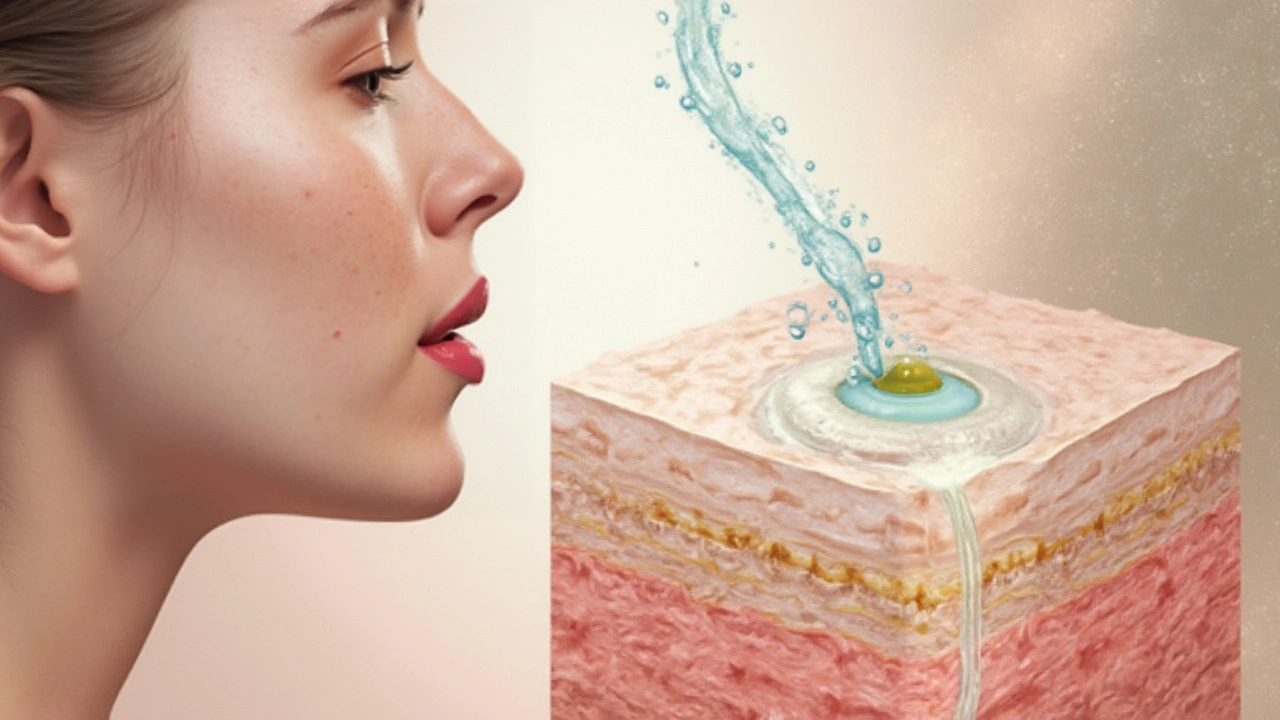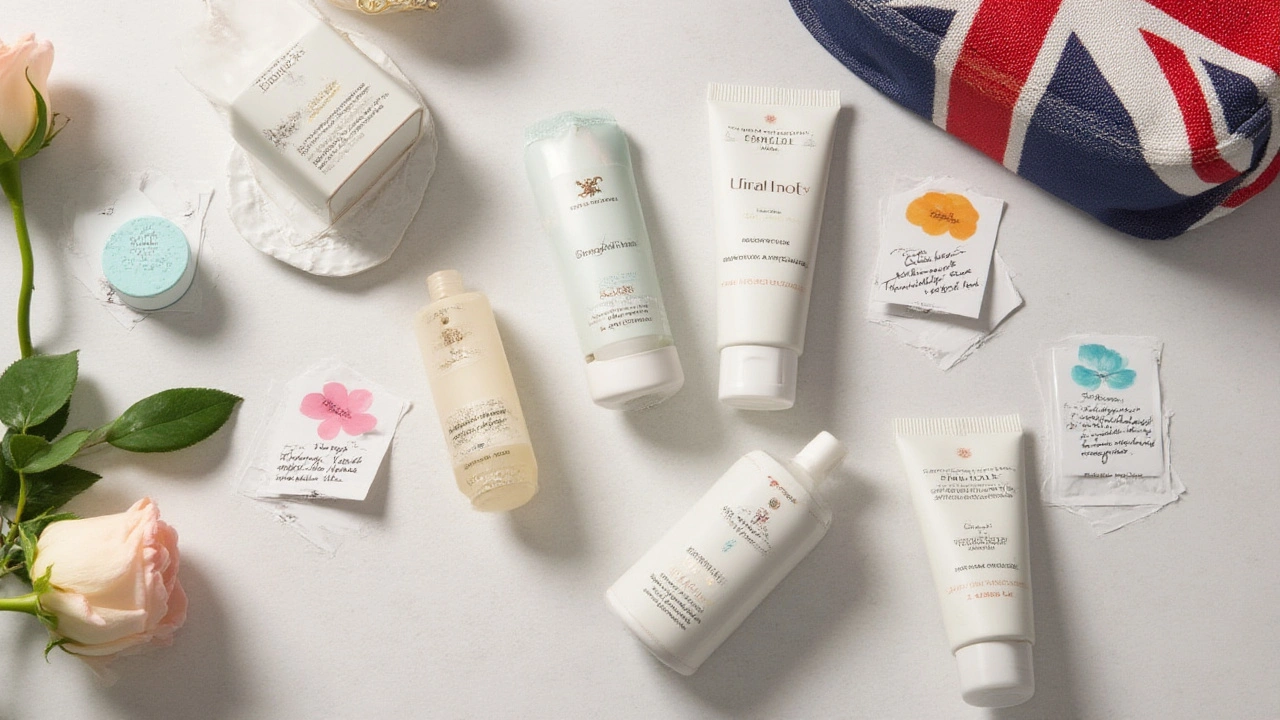Ever wondered why your regular creams sometimes feel greasy or never quite soak in? That frustration isn't just in your head. The leap from classic oily ointments to featherlight, high-absorption gels started with a new invention called emulgel. Scientists blended the best of two worlds and came up with a smart formula that’s changing the way we handle skin medications, beauty routines, and even pain relief.
What Exactly Is an Emulgel?
Picture the old debate: ointment or gel? Ointments protect, but they're sticky and hard to wash off. Gels are refreshingly light but sometimes lack the punch when it comes to delivering certain active ingredients, especially oil-based ones. So, what if you could mix the best features of both? That’s where emulgels step in.
An emulgel is a hybrid made by blending an emulsion—oil and water droplets—into a gel base. This marriage lets you get active ingredients that dissolve in oil (like Vitamin E or Diclofenac) and water-loving substances delivered at the same time, with great skin feel and excellent absorption. For anyone curious, the science behind it is simple yet clever: the emulsifying agents keep water and oil evenly dispersed and the gel thickener provides that signature smooth glide and quick absorption. No more sticky residue or patchy application.
And here’s a cool fact: emulgels got their start not from the beauty aisle, but medicine. Back in the early 2000s, researchers were searching for ways to deliver pain medication through the skin without the mess. The first mass-market hits were pain gels for arthritis and sports injuries—their secret? Emulgel technology. Fast forward to today, you’ll find the same approach in acne treatments, anti-aging creams, and even fungal infection drugs. Unsurprisingly, most people say they prefer the barely-there feel of emulgels over the heavy textures of classic ointments. Who wouldn’t?
How Do Emulgels Work in Skin Care and Medicine?
The real magic lies in how emulgels turn stubborn, sometimes hard-to-absorb substances into easy-to-use topical treatments. Think of a regular oil-based cream. Sure, it works, but it’s notorious for sitting on top of the skin. Gels, in contrast, often can’t dissolve those same actives. Emulgels allow both oil- and water-loving (lipophilic and hydrophilic) ingredients to shine at the same time. This means better penetration, improved delivery, and often faster relief when you need it.
Let’s take a closer look at why this matters:
- Targeted drug delivery: Drugs like Diclofenac in pain creams absorb quickly, targeting sore spots with less risk of stomach issues (unlike swallowing pills).
- Hydration without heaviness: Moisturizers as emulgels hydrate deeper and absorb almost instantly—goodbye greasy film!
- Cosmetics with a kick: Acne gels now combine exfoliating acids with soothing botanicals, using emulgel science so the actives work together, not against each other.
Clinical studies back it up. In a 2022 clinical study, people with mild eczema tried a ceramide-rich emulgel for three weeks. Nearly 80% said their irritation dropped with zero stickiness compared to their usual balms. Another study on ibuprofen emulgels found users felt pain relief up to 50% quicker than with traditional gel, while also reporting less skin irritation.
And the cherry on top? The structure of emulgel acts like a “reservoir.” Active ingredients get slowly released through your skin, keeping effects going longer, which is pretty handy if you’re dealing with chronic conditions or long workdays. This slow-release aspect sets emulgel apart from old-school gels that deliver their goods all at once and then… nothing. No one likes reapplying, right?

Popular Ways People Use Emulgel Formulas
Emulgels aren’t just a backstage pharma thing anymore. They’ve taken over bathrooms and gym bags everywhere. You’ll spot them now in:
- Pain relief: Brands market ibuprofen and diclofenac emulgels for strains and aches. Millions swear by products like Voltaren Emulgel after sprains or joint pain because it actually absorbs and doesn’t stain clothes.
- Beauty and skin care: Fancy vitamin C or hyaluronic acid serums cloggy or drying? Their emulgel versions deliver serious moisture and glow—without breakouts.
- After-sun gels: Modern after-sun emulgels calm red, overheated skin fast, combining soothing agents with light, hydrating bases. Aloe and panthenol, anyone?
- Anti-fungal and acne meds: For fungal infections or acne, emulgels penetrate better than powders. They combine treatment with gentle moisturization, shrinking those dry, peeling side effects.
- Cosmetic actives: Peptides, retinoids, and niacinamide are now found in emulgel-based creams, so you get real anti-aging power that soaks in fast, not wasted on your pillow.
Pharmacies and online shops list hundreds of options worldwide, from prescription formulas to over-the-counter soothers. A 2023 survey in the US found that 66% of people who tried both emulgel and regular cream formats for aches said the emulgel was easier to use and preferred its feel. That’s a big win in a world full of picky skin types.
What Makes Emulgel So Effective? Science and Structure
This isn’t just “marketing fluff.” The way emulgels are made—right down to tiny molecule levels—genuinely matters. Here’s how:
- They form a semi-solid structure and can include both hydrophilic and lipophilic ingredients thanks to an emulsion mixed within a gel.
- Key ingredients are: a gelling agent (like carbomer or xanthan gum), oil (for lipid-soluble drugs), water, and sometimes solvents for better spread.
- Emulsifiers help oil mix with water, and penetration enhancers help actives get through skin’s top layer.
This means emulgels can carry more complex combos than traditional single-phased products. For example: a study published in 2024 showed that curcumin—the bright yellow compound in turmeric notorious for being hard to deliver into skin—entered the deeper skin layers three times more effectively when delivered as an emulgel versus a plain cream. Imagine delivering those stubborn plant extracts, vitamins, or pain relievers right where you need them, fast and with fewer side effects.
Curious about real numbers? Here’s a comparison table for common formats:
| Form | Absorption Speed | Skin Residue | Release Duration |
|---|---|---|---|
| Cream | Moderate | Can be greasy | Short-term |
| Gel | Fast | Non-greasy | Short-term |
| Emulgel | Very fast | Non-greasy | Long duration |
So, it’s not just the actives, but the vehicle they ride in that makes a huge difference in how quickly and how well they work—whether you’re talking pain relief, anti-aging, or just daily hydration.

Tips on Choosing and Using the Right Emulgel
Standing in a store, bewildered by rows of tubes and jars labeled as gels or creams? Here’s how to spot which emulgel to trust, and how to get the most from it:
- Read the label for both oils (like caprylic/capric triglyceride) and water-based ingredients (like aqua, glycerin), plus a gelling agent. That’s the emulgel indicator.
- If your skin is sensitive, look for fragrance-free and hypoallergenic claims. A 2023 cosmetic safety review showed emulgels are often less irritating due to their quick absorption.
- Apply to clean, dry skin and rub gently—no need for thick layers. A pea-sized amount usually goes further thanks to the high spreadability.
- If you’re using prescription emulgel (like for acne or pain), use as directed. No double-dipping because it's long-acting already.
- For tough areas (heels, elbows), emulgels can be layered under a light bandage for extra impact overnight.
- Store at room temperature—some formulas are a little sensitive to excessive heat, which can mess with texture.
- If you’re allergic to certain oils or emulsifiers, check the full ingredient deck. Rare, but not impossible.
Thinking about cost? Don’t let fancy packaging fool you. Many of the best emulgels are affordable and sold at regular drugstores, but some higher-end beauty brands offer “custom” blends with trendy actives. It really comes down to what your skin likes best—read reviews and try a patch test if you’re switching brands. And a tip for parents: emulgel diaper creams are picking up huge attention because they spread easier (and with way fewer tears from rubbing) compared to zinc ointments. Any parent who’s tried wrestling with a wriggling kid at 2 a.m. knows why that matters!
Feeling adventurous? Some DIYers experiment with homemade versions using safe emulsifiers and aloe gel. Just keep in mind: professional formulas undergo purity and stability testing—homemade blends might be fun, but not always reliable for long-term or medicated needs.

John Magnus
Emulgel is quite an interesting formulation in dermatological pharmacology. Its unique hybrid matrix optimizes active ingredient delivery through a biphasic system that combines emulsion and gel properties.
This synergy exploits increased skin hydration from the gel base along with enhanced dispersion of lipophilic compounds in the emulsion phase. The resultant effect yields superior transdermal absorption when compared to traditional creams or gels alone.
However, clinicians must consider the physicochemical compatibility of the bioactive compounds with this matrix to prevent destabilization or reduced efficacy. From a biochemical standpoint, the rheology of emulgel allows for effective topical coverage while minimizing residue, making it highly patient-compliant.
It's a fascinating advancement that merges formulation science with practical clinical outcomes. I’d be interested to see further pharmacokinetic studies detailing percutaneous penetration kinetics and comparative analyses with conventional vehicles.
Any thoughts on its potential impact for treating chronic dermal conditions like psoriasis or eczema?
John Blas
Wow, I did not realize there was some kind of fancy blend behind these topical gels. But honestly, does it really make a difference or is it just marketing fluff?
We've had creams and gels forever, right? So now there's this 'emulgel' which sounds like a mashup name. What real-life impact does it have on my skin and why should I switch from my usual moisturizer?
Also, the article mentions absorption but what about the feel? I hate sticky or greasy products. If it's just another step with no major benefits, I’m not interested.
Maybe someone who's used it can share a straight-up no-bull review. Because sometimes, all these “smart blends” just complicate simple skincare that’s worked for years.
Luke Dillon
This is a solid post. The concept of emulgel really shows how skincare products can evolve by combining the benefits of different bases. For those unfamiliar, gels tend to absorb quickly and are non-greasy, while creams can be richer but sometimes heavy.
Emulgels aim to merge the light texture of gels with the moisturizing capability of creams. From what I’ve read, this means they work well for people with oily or combination skin who want hydration without feeling weighed down.
I think it’s worth trying if someone struggles to find a product that balances absorption and moisture. Plus, the article mentioning tips for selecting the right formula is helpful since not all emulgels are created equal depending on active ingredients.
Curious if anyone has experience applying these in different climates or skin types?
Laura Barney
Wow, this article couldn’t have come at a better time! I’ve been struggling to find a skincare product that isn’t oily but still gives my skin ample moisture. Emulgels sound like the perfect compromise—creamy but with a gel’s refreshing finish.
The fact that it enhances skin absorption is a huge plus! It makes me wonder if the emulgel formulations can be customized with different active ingredients for targeted concerns like anti-aging or acne.
Also, the tips for choosing the best formula mentioned are vital because with so many products out there, it’s easy to get overwhelmed or buy something that doesn’t suit your skin type.
Anyone else here use emulgel in their routine? I’d love to hear about your experiences, especially how it feels throughout the day.
angelica maria villadiego españa
Honestly, I had no idea emulgels existed until recently and now I’m kinda obsessed with them. They seriously feel so much lighter than creams but deliver better hydration than gels.
One thing I appreciate is how quickly they absorb without leaving behind that unpleasant greasy layer. It really helps when layering makeup afterward or if you’re stepping out in humid weather.
What’s also intriguing is their versatility for different skin types. I’ve seen versions for sensitive skin with calming ingredients which is fantastic.
Has anyone noticed a difference in skin texture or radiance since switching to an emulgel product?
SHIVA DALAI
Indeed, the advent of emulgels represents a noteworthy advancement in topical dermatology. The utilitarian amalgamation of gel’s penetrative efficacy with cream’s moisturizing properties is elegantly presented in this composition.
In clinical application, such formulations may provide enhanced therapeutic outcomes for patients with diverse cutaneous disorders by facilitating superior bioavailability of active moieties.
I endorse the emphasis placed on judicious selection of appropriate emulgel formulations, as indiscriminate use may engender suboptimal results due to variable physicochemical profiles.
Moreover, further investigative trials would substantiate the efficacy claims and elucidate potential contraindications or sensitivities.
Have practitioners incorporated emulgels routinely in their protocols, and what anecdotal or empirical evidence supports their widespread adoption?
Vandita Shukla
Allow me to chime in with some critical observations that might be overlooked. While emulgels sound technically impressive, the formulation intricacies matter immensely.
Not all emulgels are created equal – variations in surfactant types, base polymers, and active agents drastically influence stability and penetration. This could affect clinical efficacy or even cause irritation, especially in sensitive populations.
Additionally, marketing often glosses over how sometimes these hybrids may have shelf-life issues or be prone to phase separation without proper formulation controls.
To properly evaluate, dermatologists and chemists must collaborate to understand each product’s compositional parameters. Without transparency in ingredient proportions, it’s difficult to gauge the true innovation here.
What specific compounds or brands have proven reliable in controlled studies?
Jessica H.
Reading through the discussion, I feel compelled to express skepticism toward the overenthusiastic marketing of emulgels. Sure, the science sounds promising on paper, but there’s often a glaring disconnect between clinical efficacy and consumer experiences.
Moreover, many products labeled as emulgels are just repackaged traditional creams with minor tweaks, aiming to capitalize on buzz terms rather than actual formulation innovation.
Clinicians should caution patients to scrutinize ingredient lists and avoid inflated promises. It’s crucial to recognize that skin absorption is a complex process influenced by numerous factors beyond just the vehicle.
Until substantial peer-reviewed evidence corroborates these claims, I advise a measured approach before wholesale endorsement.
Marc Clarke
This post and all the comments got me thinking about how skincare must truly be a personalized journey. What works wonders for one person may be meh for another.
Emulgels seem like a clever innovation designed to bridge the gap between heavy creams and drying gels. But at the end of the day, we each must listen to how our skin reacts and adjust accordingly.
In my experience, switching to something lighter and more nourishing always results in a happier, more resilient complexion. It’s also about consistency, hydration, and protection.
So for anyone curious, it might be worth trying an emulgel, but keeping expectations realistic. Feel free to share your trial stories!
Jeremy Wessel
To sum up the main point simply: emulgel’s main advantage is improving delivery of actives through a hybrid base, which might enhance therapeutic outcomes.
But you have to choose the right formulation for your skin type and condition. There’s no one-size-fits-all here.
They’re less greasy than creams and more moisturizing than pure gels, so ideal for many, especially combination or oily skin.
Stick to trusted brands and ingredients backed by research, rather than hype.
Have others found them helpful for specific skin issues like dryness or irritation?
Tom Saa
Well, philosophically speaking, isn’t the idea of an emulgel just a reminder that everything in life is a blend—too much or too little of one thing rarely suffices?
In skincare too, finding balance is key, be it moisture, absorption, or texture. Emulgel embodies this equilibrium in a bottle.
Personally, I wonder if there’s more to these formulations that speaks to our innate need for harmony, not just superficially but deeper on a sensory and even metaphorical level.
Does anyone else feel there’s a kind of poetry in the science of these topical hybrids?